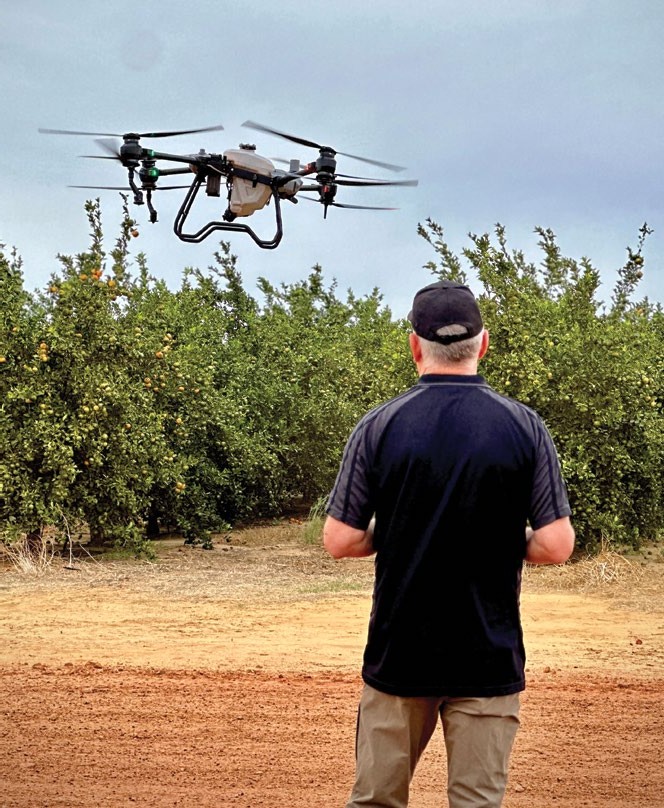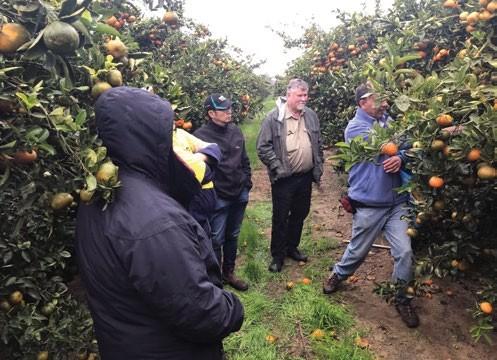WA CITRUS update
Orchard
Management
Good coverage and calibration lay foundations for good pest management
Following our theme of looking to the future and integrated pest management, our field day event in May included a demonstration of a drone that does spray application.
Words Bronwyn Walsh, Industry Development Manager, WA Citrus and Rachelle Johnstone, DPIRD
THE use of drones in agriculture is being explored across the different industries. In challenging weather conditions, Gary Rentenaar and Judy Zhu Australia Agritech demonstrated the spraying capability of the DJI AGRAS T40 drone. The DJIM3 drone. A map of the orchard is uploaded into the software. This is then used by the spray drone to guide its route. Different sized drones are suitable for different tasks. They have been used in hilly country where it is difficult to get tractors and to replace helicopters. Their role in orchards in WA is still being explored. Current limitations include volume capacity and battery run-time.
The presentation also provided a reminder that effective spray coverage is essential for management of pests and diseases. Correct setup, operation and maintenance of equipment is important. Ensure good coverage by:
• Calibrating your sprayer at least annually
• Maintaining nozzles, pumps and hoses
• Choosing the right nozzle for the right job
• Calculating and checking speed of tractor
• Using water sensitive paper to review where your spray is landing in the crop
• Avoiding poor spray conditions (windy, wet weather)
• Regular tree pruning and skirting will help with spray penetration
Rachelle Johnstone from DPIRD introduced the presentation as part of the national integrated pest and disease management project. This is funded by national citrus levy and contribution by the Australia government.
Thanks to EE Muir for providing water sensitive paper and equipment for the spray application demonstration. Thanks to Agrifresh for hosting the event.
For future events more information was requested on new chemicals that are available and what to do when Citrus gall wasp arrives in your orchard.
Managing crop load with pruning
In July Steven Falivene from NSWDPI visited the afourer mandarin orchards in WA from Harvey to West Midlands.
Some of the lessons learned were:
• Different rootstocks influence the level of growth of the scion (variety grafted on to rootstock)
• Different ages of tree mean different levels of pruning may be required
• Different costs —hedging vs hand pruning
• Level of pruning —in some instances trees, and yield, can recover from a hard prune, but can affect cashflow in the short term
Pruning since trees were young has set the trees up with a good shape and relatively smooth yields from year-to-year.
Hedging once trees are bigger can be more cost effective.
Reviewing management practices will help to even out the load for next year. This year was a light year for early mandarins and a heavy year for late season mandarins.
Monitoring seasonal outlook and water management
The low water availability in some regions following dry summer and autumn conditions prompted a brief review of the seasonal outlook for May to July at the field day during May.


The implications of low rainfall on irrigation management decisions can be worked out by answering some key questions:
• How much water required in the root zone?
• How much water the crop uses each day?
• How much water the irrigation system applies?
These questions are discussed in a range of materials on the DPIRD website, including Citrus irrigation recommendations in Western Australia, www.agric. wa.gov.au/water- management/citrus-irrigationrecommendations-western-australia?page=0%2C1.
More information on training in irrigation basics and to get the best out of soil moisture monitoring technologies was requested by those at the field day.
FOR MORE INFORMATION
Bronwyn Walsh, 0400 873 875.
This is funded by the national citrus levy and contribution by the Australia government.
Contacts
WA Citrus Office
Building 98, 3 Baron-Hay Court,
South Perth WA 6151
Bronwyn Walsh industry development manager
m: 0400 873 875
Helen Newma biosecurity officer
e: biosecurity@wacitrus.com.au
WA Citrus Committee
Joseph Ling chair
m: 0417 828 238
Shane Kay
Andrew Pergoliti
Cliff Winfield
Daniel Ying
Graham Tanner
About
WA Citrus is the industry body representing citrus growers and industry in Western Australia.
WA Citrus aims to:
• Assist in the development of a profitable and sustainable citrus industry in WA
• Provide services, facilities and support to assist WA citrus growers supply premium citrus in the local, national and export markets
• Assist with growing the consumption of WA citrus fruit